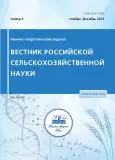Breeding characteristics of farm guinea fowls
- Autores: Zabiyakin V.A1, Zamyatin S.A2, Maksutkin S.A2
-
Afiliações:
- Mari Agricultural Research Institute - Mari Agricultural Research Institute - Branch of Federal Agricuctural Research Center of the North-East named N. V. Rudnitsky, Mari State University
- Mari Agricultural Research Institute - Mari Agricultural Research Institute - Branch of Federal Agricuctural Research Center of the North-East named N. V. Rudnitsky
- Edição: Nº 6 (2023)
- Páginas: 83-86
- Seção: Articles
- URL: https://journals.rcsi.science/2500-2082/article/view/233587
- DOI: https://doi.org/10.31857/2500-2082/2023/6/83-86
- EDN: https://elibrary.ru/WRFPWH
- ID: 233587
Citar
Texto integral
Resumo
Sobre autores
V. Zabiyakin
Mari Agricultural Research Institute - Mari Agricultural Research Institute - Branch of Federal Agricuctural Research Center of the North-East named N. V. Rudnitsky, Mari State University
Email: zamyatin.ser@mail.ru
S. Zamyatin
Mari Agricultural Research Institute - Mari Agricultural Research Institute - Branch of Federal Agricuctural Research Center of the North-East named N. V. Rudnitsky
S. Maksutkin
Mari Agricultural Research Institute - Mari Agricultural Research Institute - Branch of Federal Agricuctural Research Center of the North-East named N. V. Rudnitsky
Bibliografia
- Буяров В.С., Ройтер Я.С., Кавтарашвили А.Ш. и др. Оценка племенных качеств сельскохозяйственной птицы мясного направления продуктивности (обзор) // Вестник аграрной науки. 2019. № 3 (78). С. 30-38.
- Забиякин В.А., Замятин С.А. Скорость роста и мясные качества цесарок содержащихся в условиях фермерского хозяйства // Аграрная наука Евро-Северо-Востока. 2021. №22(4). С. 581-588. DOI: https://doi/org/10.30766/2072-9081.2021.22.4.581-588
- Забиякин В.А. Разведение цесарок в России // Эффективное животноводство. - 2017. № 3.(57). С. 24-28.
- Производство мяса и яиц цесарок: Методические рекомендации. Под общ. ред. Я.С.Ройтера. Сергиев Посад, 1993. 22 с.
- Ройтер Я.С., Шашина Г.В., Дегтярева Т.Н. и др. Разведение цесарок в фермерских и приусадебных хозяйствах // Птица и птицепродукты. 2017. №2. С. 29-31.
- Ройтер Я.С. Цесарки // Руководство по содержанию и разведению / М. 2014. 218 с.
- Ройтер Я.С. Использование генофонда сельскохозяйственной птицы в селекционной работе. Птица и птицепродукты. 2016. № 3. С. 45-47.
- Ройтер Я.С., Шашина Г.В., Дегтярева Т.Н. и др. Современная программа селекции цесарок // Птицеводство. 2019. № 4. С. 15-19.
- Ройтер Я.С. Гусева Н.К., Русецкая Т.П. Особенности селекционной работы с цесарками // Птицеводство. 2016. № 3. С. 7-11.
- Фисинин В.И. Генетические ресурсы сельскохозяйственных животных России // Достижения науки и техники АПК. 2014. № 8. С. 15-19.
Arquivos suplementares









